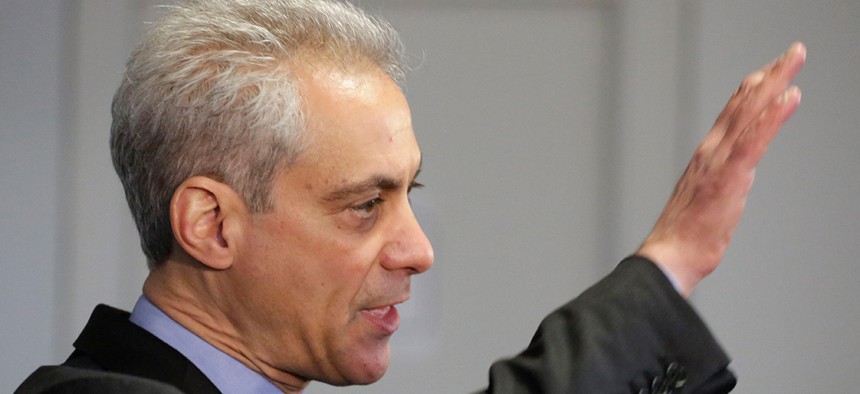Rahm Emanuel and the Tale of Two Cities

M. Spencer Green/AP
Growing urban inequality has made mayors' jobs harder across the country.
Rahm Emanuel, the pugnacious Chicago mayor reelected this week after a grueling runoff, created plenty of his own problems with a prickly personality. But Emanuel's tortured path to a second term also crystallizes the larger challenge of governing cities amid widening income inequality and growing racial diversity.
Though America's big cities still face big challenges, many are trending up. All of the 100 largest metro areas are again adding jobs, often in innovative knowledge-based industries. Young college graduates drawn to urban experiences are driving a wave of economic rejuvenation evident from the row of bustling bistros along 14th Street in Washington to the tech start-ups sprouting in San Francisco's SoMa and Los Angeles' Silicon Beach.
(RELATED: Rahm Emanuel and the Unraveling of Chicago)
But cities also face discontent from struggling communities that understandably feel left behind. The charge that New York had become "a tale of two cities"—sparkling with opportunity for the elite, but neglecting the needy—powered liberal Bill de Blasio's election as mayor in 2013. In Chicago, that was the also the central argument from Jesus "Chuy" Garcia, a Cook County commissioner backed by the local teachers union who forced Emanuel to a runoff before faltering on Tuesday.
One reason Garcia lost is that he didn't formulate plausible prescriptions for the problems he bemoaned. But that doesn't invalidate his diagnosis. Even as growth resumes, cities are struggling to connect their low-income, preponderantly minority neighborhoods to their blossoming new opportunities. Until more of the kids reared on those gritty streets can benefit from the growth in downtown towers, the discontent that threatened Emanuel will continue to rumble.
The economic chasm that de Blasio and Garcia decry is no illusion. As the Brookings Institution's Metropolitan Policy Program recently reported, income inequality is wider in the nation's 50 largest metropolitan areas than elsewhere. In Chicago, households at the 95th income percentile earn 12.5 times as much as those at the 20th percentile—a daunting gap still exceeded in seven cities.
Data from the "National Equity Atlas" compiled by PolicyLink, a research institute, and the University of Southern California's Program for Environmental and Regional Equity deepens that picture. That analysis shows the gap in hourly wages earned by whites and non-whites is wider now than in 1980, not only in Chicago but other cities such as Boston and Los Angeles.
One reason, the project's data shows, is that African Americans and Hispanics still earn less than whites with equal levels of education. But the largest problem is that those groups are not acquiring nearly as much education as whites. In Chicago, the share of U.S.-born black and Latino adults holding at least a four-year college degree (about one-fifth) is less than half the level among whites (nearly half.) The gap is comparably wide in other big cities such as New York and Los Angeles.
To Bruce Katz, vice president of Brookings' metropolitan program, these disparities frame cities' real choices. Garcia, he says, was wrong to argue that Emanuel's efforts to attract business to the city's downtown core somehow hurt its low-income neighborhoods. Without the jobs and tax base that a "robust downtown" generates, Katz says, "a city is not going to have a very competitive economy … and there is going to be very little social mobility." The real question for cities, he says, "is how do you bring more people along for the ride?"
Despite all the liberal sniping, Katz places Emanuel at the forefront of mayors who are "redefining what being a progressive is" by focusing both on creating jobs (for instance through the public-private partnership World Business Chicago) and equipping more of their cities' youth to compete for them. Though overshadowed by his polarizing decision to shut 49 under-performing public schools in poor neighborhoods (and his bitter personal conflict with the teachers union), Emanuel has pursued an ambitious agenda to lengthen the public school day and year; dramatically expand pre-school instruction; and restructure the city's previously dysfunctional community colleges to expand access, stress completion and tighten ties to local employers.
Combined with earlier reforms, his efforts have swelled Chicago's high school graduation rate, including big gains among African-American and Latino boys. Timothy Knowles, chairman of the University of Chicago's Urban Education Institute, says that compared to 2007, about 28,000 more high school students today are on track to graduate, an enormous increase. Over time, Knowles says, graduating more minority kids from high school and college is the only way to "create a more equitable set of conditions" and reverse widening urban inequality. "The problem for Rahm and other mayors," Knowles adds, "is that is a 10-20 year trajectory, not an electoral cycle trajectory."
For all his rough edges, Emanuel recognizes the challenge of widening inequality and produced a first-term record (including a local minimum wage hike) that responds to it. That gave him enough credibility to hold most black and lower-income (though not Hispanic) voters this week. But the strength of Garcia's challenge should impress every mayor with the urgency of using any tool they have to reconnect the "two cities" that now define almost all metropolitan areas.






